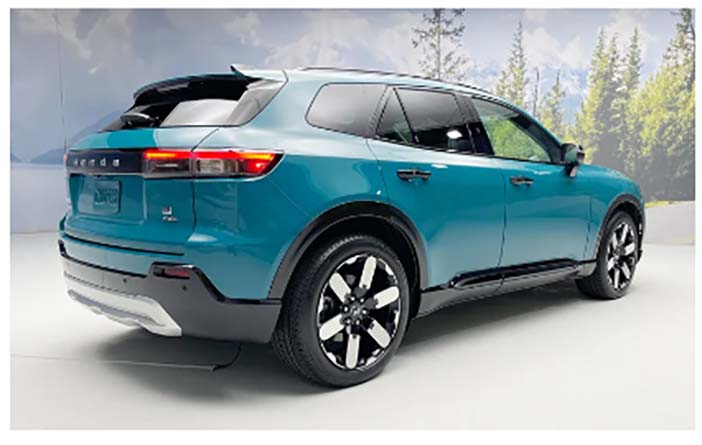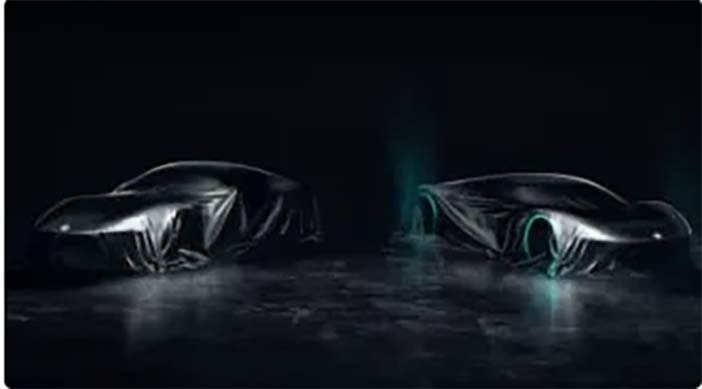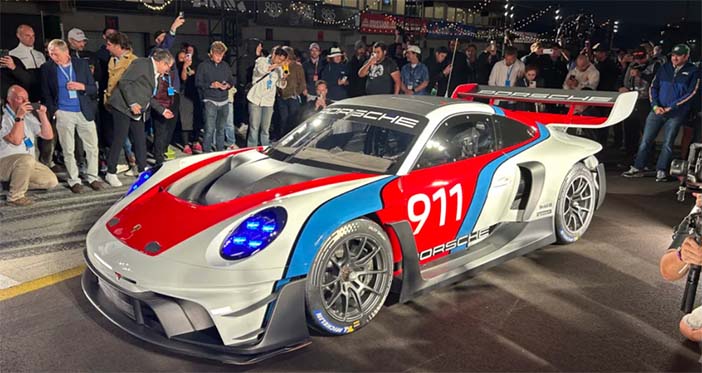+++ The American unit of HONDA said Thursday that it will release its first mass-produced electric vehicle model in North America at the start of 2024. The Prologue, a SUV which will hit the U.S. and Canadian markets, is jointly developed with U.S. automaker General Motors. The model is set to be manufactured at a General Motors plant. The Prologue is expected to be the first vehicle model by a Japanese carmaker eligible for federal tax credits offered to people who buy EVs. With a driving range of around 480 kilometers, the new vehicle will be equipped with Ultium lithium/ion batteries developed by General Motors and the Google built-in digital assistant system. Prices are expected to start at the upper 40.000-dollar level, with the tax credits seen reaching up to $7,500. Another Japanese automaker, Toyota, plans to begin EV manufacturing in the United States in 2025. Other Japanese makers are also rushing to introduce EV models to North America. S&P Global Mobility forecasts that around half of all vehicles made in the region in 2030 will be EVs. +++

+++ The Japan Mobility Show, formerly the Tokyo Motor Show, starts in less than a month. HONDA always makes statements at its home show, even if that just meant displaying a ton of products spanning a ton of possibilities. This year, Japan’s second-largest automaker is going to check all the boxes with 3 world premieres of new product, a wide variety variety, and plenty to see. My primary interest starts with the debut of the Honda Specialty Sports Concept, an electric sports car “which will enable the driver to experience the pure joy of driving (driving pleasure) and transcend the constraints of time”. The debates have already begun as to what kind of car this might be: Reborn NSX? Or reborn S2000? The image is from 2022, teased when Honda began going public with the large-scale electrification plans that will see the automaker exit internal-combustion powertrains by 2040. Let’s make it clear I have no idea if either vehicle in the teaser image has anything to do with what’s appearing in Japan next month. I only know that automaker CEO Toshihiro Mibe said last year that Honda is planning to put 2 electric sports cars on the market before the end of the decade, one a “specialty” model and one a “flagship”. The S2000 and NSX conjecture fits that description. In support of the S2000 theory, watchers note that Honda introduced the S2000 partly as a celebration of the automaker’s 50th anniversary and this year is Honda’s 75th anniversary. Also, the S2000 bowed in concept form at the 1995 Tokyo Motor Show as the Sport Study Model (SSM). In support of the NSX theory, Honda teased a Performance Electric Vision Design Study 1 month ago with lines that looked a lot like we’d expect from a futuristic NSX. The NSX has historically favored U.S. introductions, however; the original debuted at the 1989 Chicago Auto Show, the reboot debuted as a concept and later in production form at the Detroit Auto Show. +++

+++ MAZDA has a successor for the ‘6’ in the pipeline. The next edition of the family car will get rear-wheel-drive and debute in the second half of the 2020s. The next-generation 6 will be aimed largely at the North American market, where it will help Mazda cement its newfound premium positioning, though it will also be sold in other markets such as Japan. Visually, it will eschew the traditional 3-box design and instead adopt a sleek-looking, fastback-like silhouette; this should ensure it doesn’t get overshadowed by crossovers like the CX-60. Its front end will fall in line with the brand’s Kodo design language. Many of the sedan’s underpinnings, including the rear-wheel-drive platform, will come from the CX-60. Globally, the range of available engines will include a 2.5-liter 4-cylinder, a 3.3-liter straight-6 and a 3.3-liter turbodiesel straight-6. Rear-wheel-drive will come standard, and all-wheel-drive will be offered at an extra cost. The next-generation Mazda 6 won’t make its debut until 2025 at the earliest. If the new edition 6 is indeed on its way, it will land as a very unique car. With both the Opel Insignia and the 4-door Volkswagen Passat gone, the non-luxury D segment sedan is about to die. This means that, on paper, the next 6’s closest competitors would come from German luxury brands like BMW and Mercedes-Benz. Pricing, equipment and build quality are among the factors that will decide whether the Mazda is a credible rival to the 3-Series, but it sounds like de Japanese company knows exactly what it’s shooting for. +++
+++ MITSUBISHI plans to withdraw from production in China due to sluggish sales of gasoline-powered vehicles in the country. The Japanese automaker has entered final talks with joint venture partner Guangzhou Automobile Group on the matter, informed sources said. Mitsubishi started production in China in September 2012 through a joint venture it set up with Guangzhou Automobile Group and major Japanese trading house Mitsubishi Corp. In November 2022, Mitsubishi launched its Outlander gasoline-powered SUV in China. However, due to sluggish sales amid the popularity of electric vehicles, the company has suspended local production since March this year. Amid the rapid EV shift in China’s auto market, other Japanese automakers, including Nissan and Honda, are also facing sharp sales declines and reviewing their strategies. +++
+++ NISSAN and RENAULT are letting go of their common purchasing organization in favor of a new, project-by-project set-up, a sign the carmakers are growing further apart after striking a broader deal to rebalance their troubled alliance. The French carmaker has briefed employees on how roles previously linked to the alliance will change, Renault said in an emailed statement. By the end of the year, the alliance’s common purchasing organization (viewed as one of the most successful elements of what otherwise turned out to be a fraught relationship) will evolve into distinct teams focused on specific projects, Renault said. The new setup reflects Renault’s efforts to grow more independent from its Japanese partner after years of tensions within the alliance. CEO Luca de Meo has been revamping the French carmaker’s corporate structure to better manage the industry’s costly shift to electric vehicles while bolstering profits. To fix the alliance, De Meo worked with Nissan CEO Makoto Uchida to identify a series of common projects that could rekindle the relationship, notably in Europe, Latin America and India. Going forward, the leading company of a given project will have autonomy to move that project forward, Renault said. This approach will help both companies become more agile at a time when challenges in the automotive industry have grown more regional due to differences in regulations, connectivity and supply chain needs, according to the French carmaker. The new alliance agreement has given Renault and Nissan more freedom to pursue other partnerships. This resulted in Renault pooling its legacy combustion-engine assets with China’s Zhejiang Geely Holding and working with Qualcomm on semiconductors. Renault also is carving out its electric-vehicle and software assets to create a separate entity, known as Ampere, that it wants to list in an initial public offering in 2024. Renault earlier this year agreed to lower its stake in Nissan to help smooth over frictions that emerged after the 2018 toppling of former alliance chief Carlos Ghosn. In July, Nissan finalized plans to invest as much as €600 million in Ampere. Transactions linked to the rebalancing deal are still expected to close in the 4th quarter, Renault said. +++
+++ The 7th Rennsport Reunion is officially underway at Laguna Seca and PORSCHE just used the international gathering of all things as a backdrop to present a new race car. It’s called the 911 GT3 R Rennsport and it’s a limited-production GT3 R-based racer designed for maximum performance on the track. What makes the rennsport special edition unique is that it doesn’t abide by typical racing series rules. You see, the regular 911 GT3 R is designed with FIA GT3 competition rules in mind. Porsche threw those out the window when engineering the GT3 R rennsport to give the 77 owners (yes, only 77 will be produced) the most performance it can muster. Visually, that means almost the entire exterior is changed from the GT3 R it’s based on, retaining only the hood and roof from the regular GT3 R. The result of Porsche’s work is a race car that is both more aerodynamically efficient and produces more downforce. As a few examples, Porsche deleted the traditional mirrors for cameras that can be viewed via video monitors in the cabin. The gigantic new wing necessitated additional vertical supports to withstand the newfound levels of downforce. And the wide open rear fascia is designed to both reduce weight and provide a glorious view of the machinery within. Not having to follow powertrain rules means the 4.2-liter flat-6 (still rear-mounted) that revs to 9,400 rpm makes even more power, as Porsche ticks the needle from 565 horses up to 620 horsepower in the rennsport. Porsche says this version of the engine has specially-designed pistons and camshafts, and it’s also optimized to run on bio-ethanol fuels. However, Porsche says you can still pump conventional fuel without a problem, too. The exhaust system is new and completely without mufflers to create “an authentic and extremely emotional engine sound,” according to Porsche. That said, two other exhaust systems car be optionally fitted that have catalytic converters and mufflers so that you can run the car on tracks with noise restrictions legally. The sequential 6-speed gearbox is almost entirely unchanged, but Porsche says it gave the car a higher 6th gear to increase top speed by 20 Kph over the standard GT3 R. There’s nothing different about the chassis (it’s still rocking a double-wishbone front and multi-like rear with KW racing shock absorbers) but a new Michelin tire compound was developed specifically for this car that has improved warm-up and drivability characteristics compared to the GT3 R. Additional minor improvements include unique brake pads with titanium backing plates (saves a couple kilos), a new lighter fuel tank and the elimination of the air conditioning system. Admittedly, the ultra-rich collectors who buy these cars to actually use might miss air conditioning, but Porsche says this car is all about weight reduction and is targeting a 1.240 kilo curb weight. I do mean rich, too, because the GT3 R rennsport rings in with a base price of €951.000. That’s before options, taxes and transportation fees. The 77 folks who manage to buy one will have their choice of 7 different exterior colors and 3 different paintwork designs. For a race car, that’s a lot of customization, as Porsche says a few of the 7 paint options include Ruby Stay, Signal Orange and Agate Gray Metallic. The 3 paintwork designs on offer include “Rennsport Reunion Design,” “Flacht Design” and “Speed Icon Design”. +++

+++ TOYOTA ’s global sales rose 9% in August from a year earlier to a record 923.180 vehicles thanks to an improvement in supply conditions and stronger demand. Global production rose 4% to a record 924.509 vehicles, including subsidiaries Daihatsu and Hino, the Japanese carmaker said Thursday. Sales of Toyota and Lexus brand cars grew more than 3% in Europe, mostly in Italy, Spain and England. But they dropped 4% in Asia, with a 6% decline in China, where the company and other legacy carmakers like Volkswagen face tough competition from Tesla and Chinese electric-vehicle makers such as BYD. Toyota’s sales in Japan grew 45% from a year earlier in August, and 63% in South Korea. The world’s best-selling carmaker has told suppliers that it plans to make 150,000 EVs this year, 190.000 in 2024 and 600.000 in 2025. Toyota sold 11.880 battery EVs in August, bringing its total this year to 65.467. That’s more than double the 24.000 it sold in 2022, but still a far cry from the 1.5 million that chief executive officer Koji Sato vowed to sell every year by 2026. The company didn’t release August EV production figures Thursday. Earlier in September, Toyota invited journalists on a tour of its factories to showcase the technology it is developing to mass produce battery EVs. With a similar workshop in June, the company continues a publicity campaign to convince stakeholders that it has the means and conviction to catch up and compete with global EV frontrunners like China’s BYD and Elon Musk’s Tesla. Meanwhile, Honda said its global output fell 2% from the same month last year to 338.434 vehicles in August. Production grew 22% in North America, but fell by 30% in China. Nissan’s global output declined 3% to 279.237 units, including a 43% drop in China. Global sales rose 1% to 258.371 vehicles. Mitsubishi, which is ending its China operations, saw sales in the country slump 87% to just 249 vehicles in August. Sales in Japan rose 3% to 7.412 units. Global output dropped 11% to 74.225 vehicles. +++

